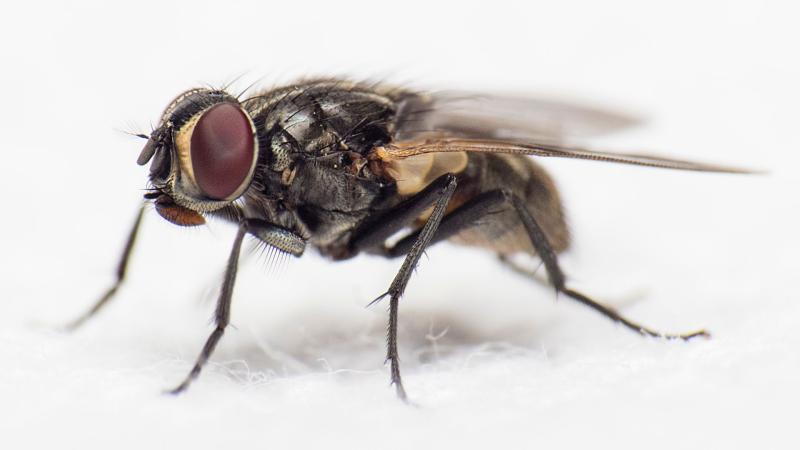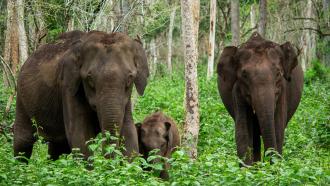
Researchers study the interplay between biology and mechanics to understand how flies land inverted on ceilings.
Skilled pilots somersaulting their planes high up in the sky, though awe-inspiring, may come across as a sophisticated act only our complex brains with a hundred billion neurons, can peform. But, can you believe that tiny flies, which have only about a hundred thousand neurons, can do the same? In a new study, researchers from the National Centre for Biological Sciences (NCBS), Bengaluru, and the Pennsylvania State University and Colorado State University in the USA, have studied how flies land on ceilings. The researchers have also explored how the fly’s brain integrates visual and balance-related inputs from the surroundings to generate appropriate movement in the wings and legs to achieve a perfect landing.
“Our work is the first to provide the complete scope of behaviours of the fly landing upside-down on the ceiling,” says Prof Bo Cheng.
He is an Assistant Professor of Mechanical Engineering at the Pennsylvania State University and the corresponding author of the study. Published in the journal Science Advances, the study is also the first to understand how the wings of the flies move during such landings. The findings have implications for designing energy-efficient flying robots and drones.
Many flying insects, like flies and mosquitoes, perch on ceilings upside down at the blink of an eyelid. It was thought that these insects fly towards the ceiling, hit it and use their feet to cling on. However, for the first time, the current study uncovers the complex manoeuvres involved in inverting their bodies to land on the ceiling.
The researchers studied the landing behaviour of blue bottle flies (Calliphora vomitoria). They used high-speed videography to record the movements of these flies in a small testing chamber. They analysed how its different body parts, like the wings and legs, moved during a successful and a failed landing.
A fly lands using somersaults. Credit: Bo Cheng and Pan Liu, the Pennsylvania State University
The study found that flies start by accelerating upward, and then rapidly rotate their body, extending their legs, before the landing. Their central motor system controls these movements. Finally, they grab the ceiling with their legs and land by swinging their body as in a cartwheel, placing their feet firmly on the roof.
“For many engineers and biologists, this is a complicated acrobatic feat,” remarks Prof Cheng.
The flies showed four types of manoeuvres — one involving somersaults, another involving rolling, another as a combination of the two, and one where they swung their bodies around with the help of their legs. During each manoeuvre, the body parts of the fly moved differently at varied speeds and angles.
A fly lands using somersaults and rolling. Credit: Bo Cheng and Pan Liu, the Pennsylvania State University
“What’s amazing is that our results seem to suggest that all of these behaviours are finely controlled by visual information the flies receive prior to landing,” says Prof Cheng. These sophisticated acrobatics also help the flies save energy and effort needed to land. “So they’re quite smart,” he says.
Not all flies seem to be successful in their first attempt at such nuanced landings! Some of them failed miserably and collided head-on with the ceiling. The failed flies either insufficiently inverted before the touch-down, or were too early to rotate. Sometimes, the leg extension was delayed, resulting in improper positioning of their legs on the ceiling. However, they all recovered in subsequent efforts and hovered at low speeds underneath the roof. They then grabbed it with their legs and landed successfully with a body swing.
A failed landing due to early body rotation. Credit: Bo Cheng and Pan Liu, the Pennsylvania State University
“As engineers, a crash landing would be seen as a failure in an engineering system. However, at the scale of insects, it can be an effective way to land and redirect energy,” explains Prof Jean-Michael Mongeau. He is also an assistant professor of Mechanical Engineering at the Pennsylvania State University and an author of the study.
The study also explores how the brain integrates the inputs it receives from different sensory cues and translates them into coordinated movements of the legs and wings to help in the landing. The researchers looked at two such signals — one from the eyes and the other from the halteres. Optical signals are processed by a series of neurons in the optic lobe of the fly. Halteres are hind wings modified into specialised mechanosensory organs.
“The brain has an incredibly difficult task of putting together information coming in from these two channels. It somehow makes sense of it all and does so extremely rapidly,” explains Prof Sanjay P Sane from NCBS, who is an author of the study.
Based on these sensory inputs, the brain commands the muscles to contract and cause the wings to move in precise ways — all in a few milliseconds. Studying this interplay could provide critical insights into how the brain works and controls movement, even in humans, say the researchers. It could also help develop better prosthetics in the future. “That’s what makes a neurobiologist like me very, very fascinated with this behaviour,” shares Prof. Sane.
Apart from helping to understand the workings of the brain, this study can also aid in the design of aerial robots and drones that can land upside-down. Robotic engineers can use trajectories taken by these flies to draw motion algorithms, which can then be applied to small robots. Since massive amounts of energy are needed to keep a robot flying, the findings of the study can help design perching robots. Instead of flying, these energy-efficient robots can sit on tree branches or building ceilings and perform the intended task.
The study brings together insights from the computational and mechanical intelligence used by flies to control their speed and orientation during an upside-down landing. For millions of years, these critters have mastered this art, which we are now starting to learn by imitating them.
"This is a popular approach right now in robotics, where we learn from the experts and then improve with reinforcement learning," concludes Prof Cheng.






